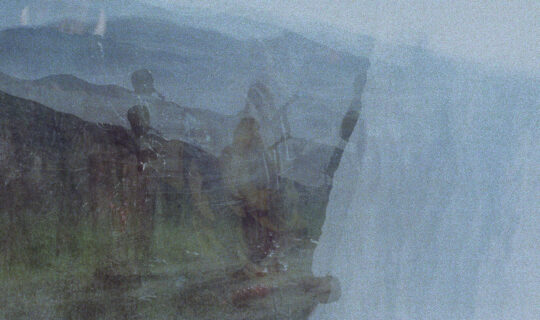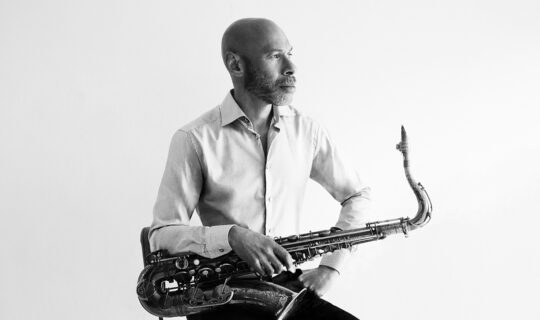December 20, 2012
On June 28, 1962, at the final studio session of its initial Blue Note run, the original lineup of the 3 Sounds—pianist Gene Harris, bassist Andrew Simpkins, and drummer Bill Dowdy—made music perfectly in line with what they’d been laying down for the label since 1958. On “Witchcraft,” “Stay as Sweet as You Are,” and “Red Sails in the Sunset,” the only tunes released from the date, the band is its usual self: cool, greasy, economical, and acoustic. But when the Sounds reappeared on Blue Note with 1966’s Vibrations, the vibe was radically different. For starters, the first instrument heard on Vibrations was organ, which Harris had overdubbed on three tracks. And the band was now moving to the beat of a funkier drummer—replacing Dowdy was Ohio player Kalil Madi, who first surfaced as a Sound on Today’s Sounds, released on the Limelight label earlier in the year.
The Sounds would continue making music in this vein on three additional studio albums for Blue Note, the last of which is 1969’s Soul Symphony, the final release by the trio. The breakup hardly indicates failure, though; the Sounds parted ways at the height of their powers, having explored brave new worlds from 1966 to 1969.
In addition to introducing the world to Harris’s organ playing, Vibrations, recorded on October 25, 1966, at Rudy Van Gelder’s Englewood Cliffs, New Jersey studio, brought non-jazz songs into the Sounds’ repertoire. In among standards like “Yeh Yeh” and John Lewis’s “Django” are pop staples like “Fever” and “Let’s Go Get Stoned,” the latter of which had been a number one hit for Ray Charles earlier in the year. But the most interesting moments on Vibrations are when Harris adds ecstatic, ebullient organ to the proceedings. On “Something You Got,” “It Was a Very Good Year,” and the Harris original “The Frown,” the keyboardist sits at the organ for heads and solos, accompanying himself on piano below it all. “The Frown” also sees him soloing on piano over organ harmonies.
“I’d been playing around on organ for kicks every once in a while, sitting in for Groove Holmes, Jack McDuff and Jimmy Smith,” Harris tells Leonard Feather in the original liner notes. “When Jimmy said I sounded pretty good, I decided it might be an interesting experiment to comp for myself on one instrument while I played a solo on the other.”
In the spring of ’68, the Sounds went way out West to record the second studio album of their encore Blue Note journey. Ensconced in Liberty Studios in West Hollywood from April 10 to 12, the Sounds brought in an orchestra to help realize Coldwater Flat, their most imaginative project up to that point. With arrangements and conduction by Blues and the Abstract Truth mastermind Oliver Nelson, and featuring leading Los Angeles saxophonists Frank Strozier and Plas Johnson, the orchestra adds wild winds and swelling interjections to immortal tunes like “Georgia on My Mind” and Burt Bacharach’s “The Look of Love.” The album reaches its peak with an arrangement of the Nat Adderley composition “Do Do Do (What Now Is Next),” first heard on the 1967 Cannonball Adderley album 74 Miles Away/Walk Tall. Beginning with a bold, sturdy ostinato from Simpkins and a pushing, quasi-rumba beat from drummer Donald Bailey (who had taken over for Madi in ’67), Nelson’s arrangement of “Do” finds Harris supporting the horns on an explosive, uplifting melody, a grand unified theory that sets the track ablaze with feeling.
For Elegant Soul, the third studio hit of this era, the Sounds returned to La-La Land with a pair of important new collaborators. At RPM Studios on September 19 and 20, the band welcomed its final drummer, Carl Burnett, and Chicago arranger Monk Higgins, who had been working with blues legends like Howlin’ Wolf and Muddy Waters. Higgins’s influence on the sessions cannot be overstated; Elegant Soul sees the Sounds moving even further away from jazz, recording what is essentially an R&B album. Over a laidback 6/8 groove, “Do It Right Now” plays out like a cathartic Isaac Hayes jam, replete with female vocalists cooing “oh yeah” over and over again in the background. The gorgeous title track crawls along at a snail’s pace, letting Harris’s sparkling leads really sink into the bed of strings and flute provided by Higgins’s crew. “(Sock it to Me) Harper Valley P.T.A.” is a potent, gospel-influenced boogaloo number. And powered by Burnett’s sleazy funk beat and Higgins’s percussive, snaking string lines, the oft-sampled “Book of Slim” could easily have fit on a blaxploitation soundtrack.
With Higgins at the helm again—the arranger wrote or co-wrote every piece on the album—Soul Symphony was the final studio chapter for the Three Sounds. Recorded in L.A. over three days in the summer of ’69, it was also something of a new beginning for Harris, the only original Sound on Symphony; after more than a decade with the group, bassist Simpkins departed after Elegant Soul and was replaced by Henry Franklin. Featuring an orchestra that includes Charles Mingus collaborator Buddy Collette on flutes, the album kicks off with its 26-minute title track, the most ambitious chart the Sounds would ever tackle. Opening with an unaccompanied swing beat, the thrilling “Soul Symphony” strings together a series of Higgins’s miniatures, some of which seem to pay homage to classic compositions. The suite includes a pensive moment reminiscent of a riff from Cannonball’s “Mercy, Mercy, Mercy”; a soulful exploration in 6/8 that could have been the backing track for an Atlantic-era Aretha Franklin hit; and a movement that sounds like a cross between Wilson Pickett’s “In the Midnight Hour” and Herbie Hancock’s “Watermelon Man.” Taking up all of side one, the mammoth “Soul Symphony” is a lot to handle, but not so much that one wouldn’t want to revisit it often.
In the ’70s, the members of the 3 Sounds family kept busy. Simpkins conjured deep tones for George Shearing and Sarah Vaughan; Burnett burned with Freddie Hubbard and Art Pepper; Franklin fraternized with Hampton Hawes and Bobbi Humphrey; and Harris turned in a half-dozen LPs under his own name to Blue Note. But the funky, down-home shadow of the 3 Sounds loomed large, reminding all that a great band had come and gone.
Photos courtesy of Mosaic Images




